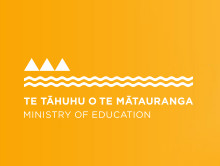Ko Reitū rāua ko Reipae
nā Pita Tīpene
Hei whakarāpopoto
He kōrero tēnei e whakaatu ana i tētahi hononga i waenganui i Whangapē me Waikato. Ka tuhia ki te reo pohewa hei whakamārama i te aroha me te harawene. Kei roto nei, ka whakamāramahia ngā whakapapa o ngā wāhi i Te Tai Tokerau.
Summary
This legend shows the links between Whangapē and Waikato. The text uses poetic language to express love, and jealousy. The text provides an explanation for some place names in Te Tai Tokerau.
|
Te momo reo tuhi |
|
|---|---|
|
Ētahi āhuatanga o tēnei momo reo tuhi |
|
I te Ākonga e Pānui ana i te Pukapuka
During Reading
1. He mahi takirua tēnei. Tuhia he whakarāpopototanga o te haerenga o Reitū rāua ko Reipae. Tuhia i te reo tautoru. Ka mutu rā, tāngia he mahere whenua e whakaatu ana i tō rātou haerenga.
This activity can be done in pairs. Write a brief summary of the journey of Reitū and Reipae. Write in the third-person. When this is done draw a map of their journey.
2. Rangahau ā-ipurangi ētahi kōrero ō nehe mai i ngā iwi o ngā ākonga. Tuhia he whakarāpopototanga o ia kōrero, ka whakaatu ki te akomanga. Tautohua ngā kaupapa matua o ia kōrero. Whakaraupapa mai i ngā kōrero katoa me ngā kaupapa matua ōrite.
Do an internet search to find out information about a legends from the tribal areas the students are from. Write a summary of the legends and share with the class. Write the key messages in the stories. Look across all stories shared and identify common themes.
3. Wānangahia ngā kupu ā-iwi nō te kōrero. Ohia manomanotia ētahi atu kupu ā-iwi, kōrero ā-iwi e mōhiotia ana e ngā ākonga.
Discuss the various dialectal words from within the text. Brainstorm other dialectal difference in words and structures the students are aware of.
4. Āta tirohia te tūtohi e whai ake nei. Whakamahia ngā kupu hou i roto i tētahi whakaari hei whakaatu ki tō rōpū ako.
Discuss the words below and use as many words as possible to create a short skit in groups to present to the class.
| Te kupu mai i te kōrero (Te Tai Tokerau) | Kupu Taurite |
|---|---|
| kihakiha | whakahā whakaroto |
| haramai tētahi āhua! | ka mau kē te wehi! |
| manene | tauhou |
| korokē | tangata |
| koniahi | noho ki te taha o te ahi |
| tīhohe | ngāwari ngā whakaaro |
| mate kanehe | arohanui |
| hoi | heoi |
| parani | mahau |
| e korekore | kāore e kore |
| taimaha | taumaha |
| kīkī | kōrero |
| raki | whaiāipo |
| patere mai | puta mai |



